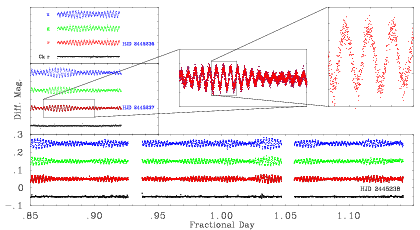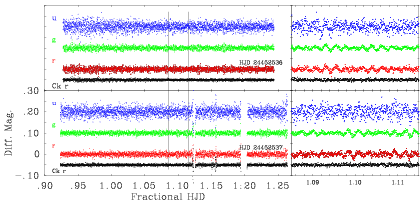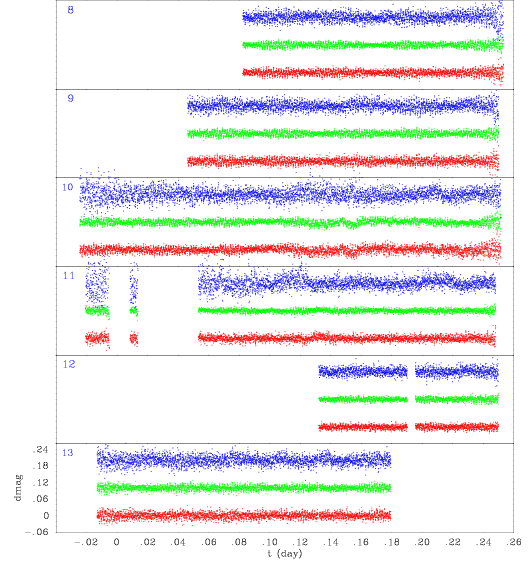 Hertzsprung-Russell diagram by Richard Powell. 22 000 stars are plotted from the Hipparcos catalog and 1000 from the Gliese catalog of nearby stars.
Hertzsprung-Russell diagram by Richard Powell. 22 000 stars are plotted from the Hipparcos catalog and 1000 from the Gliese catalog of nearby stars. Vibrations come in many shapes and forms. For a spherical star, the simplest form is a radial pulsation; the star expands and contracts but maintains its spherical shape. Other vibrations are non-radial -- shrink-stretch modes which change from sausage-like to bun-shape and back, or twisting modes, where a bulge rotates around the equator.
[ movies of l,m=0,0, 2,0 3,3 modes ]
Many stars vibrate in more than one mode at a time; each mode is associated with one frequency, but together, many different frequencies may be present.
Whatever the shape of the vibration, each one is linked to a variation in the position and temperature -- or colour -- of the star's surface. In asteroseismology, we observe various properties of a star as it varies, such as total light, colour and velocity -- which is just the rate of change of position.
[ Movie of vibrations in colour - showing star changing temperature ]
[ Simulation of line profile variation ]
The observational goals are to measure frequencies, which define the global and structural properties of the star, and to identify which modes each frequency corresponds to, in order to distinguish between models which may match the observed frequencies equally well. Therefore, asteroseismologists must to measure more than just light variations. Observationally, the next easiest quantity to measure is colour -- colour variations correspond primarily to changes in surface temperature.
 Hertzsprung-Russell diagram by Richard Powell. 22 000 stars are plotted from the Hipparcos catalog and 1000 from the Gliese catalog of nearby stars.
Hertzsprung-Russell diagram by Richard Powell. 22 000 stars are plotted from the Hipparcos catalog and 1000 from the Gliese catalog of nearby stars.
Subluminous B stars are a special type of star that are very different from the Sun and, in fact, from most other types of star. Most stars are like the Sun, they are in their youth. Such stars shine because nuclear reactions deep in their interior convert hydrogen into helium. Because a helium nucleus is slightly lighter than four hydrogen nuclei, the difference in mass is converted into energy
[image of p-p chain]
A star like the Sun converts XXX tonnes of matter into energy every second, with a nett power output of YYY watts. However, the Sun is so massive that it will continue to burn for about 10 billion years before the hydrogen in the core is exhausted. More massive stars have hotter cores, so they burn more quickly and shine more brightly. Because of this, their surfaces are hotter -- or bluer. Low mass stars are fainter and cooler than the Sun.
Stars which are burning hydrogen in their cores are known as main-sequence stars. This is because they comprise the most numerous stars in the sky and they form sequence in a diagram which compares stars' brightness with their colours. This diagram is known as an Hertzsprung-Russell diagram.When core hydrogen is exhausted, a low-mass star will expand to become a red giant. These stars have very condensed cores made of helium. Hydrogen burns to helium in a shell around the core; the shell eats its way out towards the surface of the star, adding helium to the dead core.
[ cutaway of red giant ]
Eventually, when the core grows to have a mass of about one half of a solar mass (the mass of the Sun), a new set of nuclear reactions will begin. Three helium nuclei may fuse to form a carbon nucleus. These new reactions bring the core back to life very suddenly, in an event known as the helium core flash. The core expands, the hydrogen-burning shell may be wholly are partially quenched, and the star actually dims.
[ image of 3-alpha reaction ]
The onset of core helium-burning commences a new phase in the life of a star -- for low-mass stars this has several names, depending on the chemical composition of the star and the total mass. For relatively young stars with amounts of trace elements like carbon, oxygen, and iron similar to the Sun, the stars drop slightly in brightness, but remain red -- these are know as red-clump stars because they form a "clump" half-way up the red-giant branch.
Older stars with small amounts of trace elements, or with very thin hydrogen envelopes, are known as horizontal-branch stars. This is because their hydrogen-burning shells are less active, so the stars are physically smaller and hotter. In globular clusters, these stars form a horizontal sequence in the HR diagram.
[ image of a globular cluster and HR diagram showing HB ]
See the article Stellar Maturity for more about ageing stars.
Subluminous B stars are different from nearly all of the stars above -- but they are most closely related to the horizontal-branch stars. On an HR diagram, they would lie between the main-sequence and the white dwarf sequence -- on an extension of the horizontal-branch. Because of this, they are often known as extended or extreme horizontal-branch stars. It is pretty certain these are almost pure helium core-burning stars of about half a solar mass. They have a very thin skin of hydrogen, but they present a particular problem.
In order to make an extreme horizontal-branch star, a red giant must lose nearly all of its outer layers. The trouble is this. A star evolving as a red giant will stop its evolution when the amount of hydrogen left on the surface drops below about ZZZ. If this happens before the core mass reaches 0.5 solar masses, the star may not ignite helium, and so cannot become a horizontal-branch star at all.. On the other hand, with too much hydrogen on the surface, it cannot become an extreme horizontal-branch star. So how did the sdB stars lose their outer hydrogen layer.
One solution might be related to the fact that some sdB stars are binaries. While this is attractive -- it actually turns out to be quite complicated because it seems that sdB stars come in four different flavours!
So, it seems that nature has found four different ways to make a subdwarf B star! Each of these involves an object that stars out as a double or binary star. As both stars in the binary system evolves, the more massive star evolves fastest, and becomes a red giant first. If the stars are close together material on the surface of the expanding giant will spill over onto the surface of its companion. This will change the masses of both stars, alter the orbital period and separation, and change the subsequent evolution of both stars. The result depends critically on the starting masses and the separation of the two stars in the binary.
Case 1 MS+MS > MS+GB > MS+HB > MS+AGB > MS+WD > GB+WD > CE > sdB+WD
M1= MO M2= MO P= d
Case 2 MS+MS > HG+MS > RLOF > GB+MS > CE > sdB+MS
M1= MO M2= MO P= d
Case 3 MS+MS > GB+MS > RLOF > sdB+MS
M1= MO M2= MO P= d
Case 4 MS+MS > MS+GB > CE > MS+HeWD > GB+HeWD > CE > HeWD+HeWD > Merger > sdB
M1= MO M2= MO P= d
[ figure showing HR diagram with sdB stars ]
[ figure showing HR diagram of pulsating variable stars ]
[ figure showing distribution of pulsating and non-pulsating sdB stars ]

Ultracam is an ultra-fast, triple-beam CCD camera which has been designed to study one of the few remaining unexplored regions of observational parameter space - high temporal resolution. The camera, which has been fully-funded by PPARC, saw first light during 2001 and has been used on 4-m and 8-m class telescopes in the Canary Islands and Chile to study astrophysics on the fastest timescales.
image of ultracam link to sheffield websiteKPD 2101+4401pdf ps |
 |
HS 0039+4302pdf ps |
 |
PG 0014+067pdf ps |
 |
The reduced ultracam data for several pulsating sdB stars, as published in the papers cited below, is available for public use. Any authors using these data are requested to acknowledge the source and to cite the appropriate reference. Each file is a gzipped tarball containing either three or four files.
Generally, there is one file for each ultracam channel (u', g', r'). In addition, "white light" data is included in a few cases. White light data are constructed by adding the data from all three ultracam channels, weighted appropriately to the counts for each star in each channel.
Each file is a simple ASCII files containing two columns, time and differential magnitude. The zero-point in time is unspecified -- any one requiring this information must request it from a member of the Project Team. The differential magnitudes have been rectified.